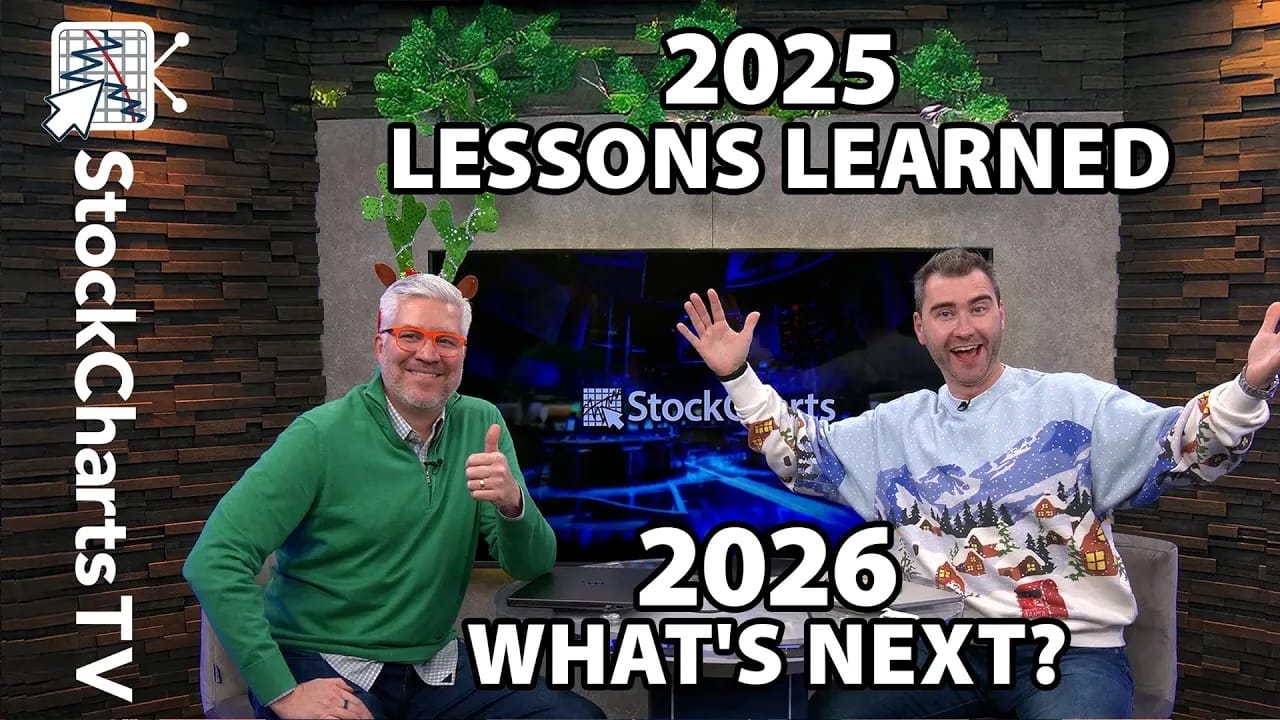OIL ETFS BREAK SUPPORT WITH SHARP DECLINES -- XLE BREAKS NECKLINE SUPPORT WITH LARGE DECLINE -- CVX, SLB AND XOM LEAD ENERGY SPDR LOWER -- WAVE COUNT INDICATES FIFTH OF THE FIFTH FOR S&P 500 -- HAS ABC CORRECTION STARTED OR JUST ENDED?
OIL ETFS BREAK SUPPORT WITH SHARP DECLINES... The 12-Month US Oil Fund (USL) and the US Oil Fund (USO) broke short-term support levels with sharp declines on Monday. Friday I wrote about the triple whammy hitting oil as Saudi Arabia increased output, stocks were down and the Dollar was up. There appears to be some spillover today. Technically, chart 1 shows USL breaking the flag trendline and its early June low with a sharp decline below 44.50 on Monday. Rising flags are bearish corrective patterns. In other words, these patterns represent a counter trend advance within a bigger downtrend. The sharp decline in early May sets the bearish tone. Todays breakdown signals a continuation of this bearish tone. The 2011 lows mark the next support area around 41.50. Chart 2 shows USO with a similar pattern. Surprisingly, the Brent Crude ETF (BNO) has yet to break down. However, chart 3 shows BNO at resistance and with a rising flag over the last several weeks. Brent Crude comes from the North Sea and is used mostly in Europe. USO and USL are based on West Texas Intermediate and NYMEX crude.

(click to view a live version of this chart)
Chart 1

(click to view a live version of this chart)
Chart 2

(click to view a live version of this chart)
Chart 3
XLE BREAKS NECKLINE SUPPORT WITH LARGE DECLINE... Oil stocks followed crude lower with sharp declines on Monday. Overall weakness in the stock market also contributed to declines in energy-related shares. Chart 4 shows the Energy SPDR (XLE) breaking neckline support of a rather large Head-and-Shoulders reversal pattern. The entire pattern extends from early February to early June. It is a bit unusual with two heads, but there is a clear neckline support area around 73. XLE broke this support with a long black candlestick on Monday. Using traditional technical analysis, the projected move would be to around 65. The height of the pattern (81 73 = 8) is subtracted from the neckline (73) for a target. I would mark first resistance at 76.

(click to view a live version of this chart)
Chart 4
CVX, SLB AND XOM LEAD ENERGY SPDR LOWER... Chevron (CVX), Schlumberger (SLB) and ExxonMobil (XOM) account for over 35% of the Energy SPDR. Chart 5 shows CVX breaking its April low with a sharp decline in early May. After a rising wedge advance back above 104, the stock broke support with a sharp decline in early June. First resistance is set at 102. Chart 6 shows SLB with a large Double Top and a big support test in May. Support ultimately held, but a new test is underway after the stock broke below its early June lows today. Chart 7 shows XOM breaking flag support and testing the March-May lows. An extended Double Top appears to be taking shape here with support at 79.

(click to view a live version of this chart)
Chart 5

(click to view a live version of this chart)
Chart 6

(click to view a live version of this chart)
Chart 7
LONG-TERM WAVE COUNT INDICATES FIFTH OF THE FIFTH FOR S&P 500 ... On May 17th, John Murphy showed a chart depicting a complete 5-Wave sequence for the S&P 500. This sequence started with the July 2010 low and extended to the April high. According to Elliott Wave Theory a 5-wave advance is followed by a correction or a major trend reversal that would suggest an opposing 5-Wave impulse decline. Chart 8 shows the S&P 500 with a wave sequence of one larger degree. Murphys 5-Wave sequence is labeled 1 to 5, while the waves of one larger degree are labeled I to V. According to this count, the S&P 500 traced out a large 5-Wave advance from March 2009 until April 2011. Note that this chart shows the S&P 500 as a 5-day EMA to smooth prices. Moreover, the S&P 500 appears to have peaked with a classic fifth (5) of the fifth (V) in April. Such a peak would argue for at least a correction that might look like an ABC zigzag and retrace a portion of the prior 5-Wave (1-5) advance.

(click to view a live version of this chart)
Chart 8
Chart 9 focuses on the advance from July 2010 to May 2011 with a daily bar chart. A clear 5-Wave sequence is visible with Wave 3 as the longest. In fact, Wave-3 looks like some sort of extended wave because of its unusual length. Also notice that Wave-1 and Wave-5 are roughly equal. This is usually the case when Wave-3 is the longest of the five waves. With a completed 5-wave sequence, an ABC correction is possible. These patterns form with a 5-3-5 sequence. Wave-A down is 5 waves, Wave-B up is 3 waves and Wave-C down is 5 waves. The first step is to estimate the decline in Wave A. Wave-A appears to break down into 5 waves and we are currently in Wave-iii of A. This means Wave-iv and Wave-v are still to come. I would estimate a Wave-A low around 1225 that would give way to a counter trend bounce, counter to Wave-A that is. This would likely retrace around 50% of Wave A. Once Wave-A is finished, we can then expect Wave-C. With Wave-C often being equal to Wave-A, the downside target would be to around 1180. A 50-62% retracement of the entire 5-Wave advance would extend to this area as well.

(click to view a live version of this chart)
Chart 9
The indicator window above shows MACD marking each correction with a dip into negative territory. MACD turned negative during Waves 2 and 4. Most recently, MACD moved into negative territory with this ABC correction unfolding. This correction may not end until MACD returns to positive territory.
HAS ABC CORRECTION STARTED OR JUST ENDED?... There are usually alternative counts when it comes to Elliott Wave. There is nothing wrong with an alternative. Chartists should be prepared for the unexpected. Alternative counts provide different scenarios for consideration. Chart 10 shows the S&P 500 with a bearish long-term scenario. The decline from October 2007 to March 2009 traced out a 5-Wave sequence that marks the start of a bigger Wave-I. The entire advance from March 2009 to April 2011 traced out an ABC correction that formed Wave-II. Notice that Wave-A and Wave-C subdivide into 5 waves and Wave-B subdivides into 3 waves. Wave-A and Wave-C are impulsive, which means they must form a 5-wave impulse sequence. Waves in harmony with the count of one larger degree are impulsive. Waves that move against the count of one larger degree are corrective. Wave-B moves counter to Wave-II, which means it must form a corrective sequence (ABC zigzag, flat etc...). Based on this scenario, the S&P 500 is now beginning Wave-III down. Third waves tend to be the longest and strongest. This would imply a target well below the March 2009 low.

(click to view a live version of this chart)
Chart 10
While I am sure that Nouriel Roubini believes a big Wave-III down is possible, I do not subscribe to the this count because some key indices did not confirm the lower high in the S&P 500. The Russell 2000 ($RUT), S&P 500 Equal Weight Index ($SPXEW) and the Nasdaq reached their 2007 highs this year. The Nasdaq 100 ($NDX) and S&P MidCap 400 ($MID) exceeded its 2007 highs. The Dow Industrials, NY Composite ($NYA) and S&P 500 were the only indices to fall short of their 2007 highs. We can blame one sector for this underperformance: finance. If this count is the right one, then the S&P 500 is starting Wave-1 of Wave-III, which would be an impulse wave down. This points to a rather strong 5-wave decline (1-5). I will wait to see if such a strong impulsive sequence forms before turning too bearish right now.











